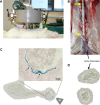Drug delivery to atherosclerotic plaques using superparamagnetic iron oxide nanoparticles
- PMID: 30587970
- PMCID: PMC6294059
- DOI: 10.2147/IJN.S179273
Drug delivery to atherosclerotic plaques using superparamagnetic iron oxide nanoparticles
Abstract
Introduction: Magnetic drug targeting utilizes superparamagnetic iron oxide nanoparticles (SPIONs) to accumulate drugs in specified vasculature regions.
Methods: We produced SPIONs conjugated with dexamethasone phosphate (SPION-DEXA). The efficacy of magnetic drug targeting was investigated in a rabbit model of atherosclerosis induced by balloon injury and high cholesterol diet.
Results: In vitro, SPION-DEXA were well-tolerated by endothelial cells. SPION-DEXA were internalized by human peripheral blood mononuclear cells and induced CD163 expression comparable with the free drug. In vivo, magnetic targeting of SPIONs to abdominal aorta was confirmed by histology. Upon vascular injury followed by high-cholesterol diet, early administration of SPION-DEXA enhanced the inflammatory burden in the plaques. Increased macrophage content and larger intima- media thickness were observed in animals treated with SPION-DEXA compared with controls. In advanced atherosclerosis, no beneficial effect of local glucocorticoid therapy was detectable.
Conclusion: Magnetic drug targeting represents an efficient platform to deliver drugs to diseased arteries in vivo. However, targeting of vascular injury in the lipid-rich environment using dexamethasone-conjugated SPIONs may cause accelerated inflammatory response.
Keywords: dexamethasone; macrophage accumulation; magnetic drug targeting; magnetic nanoparticles; rabbit model of atherosclerosis.
Conflict of interest statement
Disclosure The authors report no conflicts of interest in this work.
Figures






Similar articles
-
Accumulation of Iron Oxide-Based Contrast Agents in Rabbit Atherosclerotic Plaques in Relation to Plaque Age and Vulnerability Features.Int J Nanomedicine. 2024 Feb 20;19:1645-1666. doi: 10.2147/IJN.S430693. eCollection 2024. Int J Nanomedicine. 2024. PMID: 38406599 Free PMC article.
-
Monitoring the effects of dexamethasone treatment by MRI using in vivo iron oxide nanoparticle-labeled macrophages.Arthritis Res Ther. 2014 Jun 23;16(3):R131. doi: 10.1186/ar4588. Arthritis Res Ther. 2014. PMID: 24957862 Free PMC article.
-
Targeted Molecular Iron Oxide Contrast Agents for Imaging Atherosclerotic Plaque.Nanotheranostics. 2020 May 30;4(4):184-194. doi: 10.7150/ntno.44712. eCollection 2020. Nanotheranostics. 2020. PMID: 32637296 Free PMC article.
-
Superparamagnetic iron oxide nanoparticles: magnetic nanoplatforms as drug carriers.Int J Nanomedicine. 2012;7:3445-71. doi: 10.2147/IJN.S30320. Epub 2012 Jul 6. Int J Nanomedicine. 2012. PMID: 22848170 Free PMC article. Review.
-
Iron-based superparamagnetic nanoparticle contrast agents for MRI of infection and inflammation.AJR Am J Roentgenol. 2015 Mar;204(3):W302-13. doi: 10.2214/AJR.14.12733. AJR Am J Roentgenol. 2015. PMID: 25714316 Free PMC article. Review.
Cited by
-
Accumulation of Iron Oxide-Based Contrast Agents in Rabbit Atherosclerotic Plaques in Relation to Plaque Age and Vulnerability Features.Int J Nanomedicine. 2024 Feb 20;19:1645-1666. doi: 10.2147/IJN.S430693. eCollection 2024. Int J Nanomedicine. 2024. PMID: 38406599 Free PMC article.
-
Animal models used in the research of nanoparticles for cardiovascular diseases.J Nanopart Res. 2021;23(8):172. doi: 10.1007/s11051-021-05289-z. Epub 2021 Aug 10. J Nanopart Res. 2021. PMID: 34393623 Free PMC article. Review.
-
Iron Oxide Nanoparticles in Regenerative Medicine and Tissue Engineering.Nanomaterials (Basel). 2021 Sep 8;11(9):2337. doi: 10.3390/nano11092337. Nanomaterials (Basel). 2021. PMID: 34578651 Free PMC article. Review.
-
Effect of Chemically Modified Carbon-Coated Iron Nanoparticles on the Structure of Human Atherosclerotic Plaques Ex Vivo and on Adipose Tissue in Chronic Experiment In Vivo.Int J Mol Sci. 2022 Jul 26;23(15):8241. doi: 10.3390/ijms23158241. Int J Mol Sci. 2022. PMID: 35897812 Free PMC article.
-
Gα13 Contributes to LPS-Induced Morphological Alterations and Affects Migration of Microglia.Mol Neurobiol. 2021 Dec;58(12):6397-6414. doi: 10.1007/s12035-021-02553-0. Epub 2021 Sep 16. Mol Neurobiol. 2021. PMID: 34529232
References
-
- Libby P, Theroux P. Pathophysiology of coronary artery disease. Circulation. 2005;111(25):3481–3488. - PubMed
-
- Cicha I, Garlichs CD, Alexiou C. Cardiovascular therapy through nanotechnology – how far are we still from bedside? Eur J Nanomed. 2014;6(2):63–87.
-
- Thorat ND, Bohara RA, Yadav HM, Tofail SAM. Multi-modal MR imaging and magnetic hyperthermia study of Gd doped Fe3O4 nanoparticles for integrative cancer therapy. RSC Adv. 2016;6(97):94967–94975.
-
- Lyer S, Tietze R, Jurgons R, et al. Visualisation of tumour regression after local chemotherapy with magnetic nanoparticles – a pilot study. Anticancer Res. 2010;30(5):1553–1557. - PubMed
MeSH terms
Substances
LinkOut - more resources
Full Text Sources
Other Literature Sources
Research Materials

